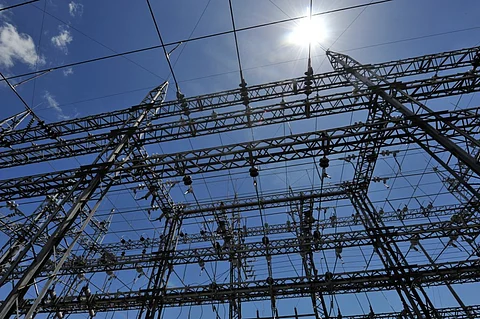
- NEWS
- the EDIT
- COMMENTARY
- BUSINESS
- LIFE
- SHOW
- ACTION
- GLOBAL GOALS
- SNAPS
- DYARYO TIRADA
- MORE

Cebu Governor Gwendolyn Garcia has expressed her support in building baseload power plants in Cebu to meet the province's need for reliable power to fuel its growing economy and population.
She emphasized the urgent need for Cebu to attain power self-sufficiency to avoid the plight faced by neighboring Panay Island which has experienced extensive blackouts recently.
"We cannot be relying mainly on others for our power. We need to be self- sufficient, not in 2027 but now," Garcia reiterated.
Based on the Department of Energy (DOE) projections on energy demand for Cebu island, it will reach around 1,400 megawatts (MW) by 2026 and will outpace supply by 2027 unless new baseload power plants are constructed. Cebu island comprises the mainland, Mactan island, Camotes Islands, and Bantayan island.
So far, indicative and committed power plant projects in Cebu only include a 240-MW solar field in Medellin, as well as around 10-MW combined oil-based generators in Lapu-Lapu City.
"I am looking after my constituencts who will suffer the inconvenience brought about by the absence of power. I am looking after the welfare of the investors and businesses who are giving employment to our people. I want to avoid the catastrophic effects of one or two power plants shutting down," the governor insisted.
AboitizPower is expanding its Therma Visayas Inc. (TVI) facility in Barangay Bato, Toledo City. Currently, TVI operates a 340-MW coal-fired power plant composed of two units of 170 MW each. TVI is a joint venture between Aboitiz Power Corp. and Vivant Corp. The expansion will be 169 MW.
The National Grid Corporation of the Philippines (NGCP) through assistant vice president and head for public affairs Cynthia Perez-Alabanza said Cebu needs to have additional power plants given its rapid population growth and increased investments after the COVID-19 pandemic.
According to the NGCP, Cebu eats half of the Power demand in the Visayas. Cebu City which belongs to the Visayan Electric franchise, consumes half of the province's demand.
"More power supply is always better," says Cebu Chamber of Commerce and Industry (CCCI) president Charles Kenneth Co.
"When there is a pressing need for power then we definitely need additional generation capacity and infrastructure," says Mark Ynoc , the president of the Mandaue Chamber of Commerce and Industry (MCCI).
Meanwhile ,The Philippine Movement for Climate Justice (PMCJ) continues to express its opposition to Aboitiz's plan for expanding coal generation in Toledo City, Cebu due to adverse health impacts plaguing residents from the operation of the existing 338-MW coal power in Barangay Bato,Toledo City. This is in light of unresolved respiratory and other health-related complaints from residents, which are believed to be caused by fly ash and other pollutions from TVI coal power plants.
"This opposition extends to the proposed construction by AboitizPower of a Liquefied Natural Gas (LNG) power plant in Naga, Cebu. Overall, this stance aligns with the call from the intergovernmental Panel on Climate Change (IPCC), supported by various studies, for fossil fuel usage to peak by 2025," says PMCJ.
"AboitizPower's proposal to expand its coal power generation by 169-MW in Toledo City, Cebu, through it's existing TVI power station in Barangay Bato, represents an escalating challenge for Cebuanos who are already dealing with expensive long-term coal power supply contracts and the negative environmental and health impacts inflicted on host communities by coal power generation," PMCJ stressed.
DAILY TRIBUNE tried to interview Visayan Electric Communications Department head Quennie Bronce but was referred to AboitizPower. As of press time, there was no reply yet.
According to PMCJ, the Aboitiz-owned Visayan Electric Company sources 65 to 70 percent of its supply from two coal power generators in Toledo City, TVI and the Cebu Energy Development Corporation (CEDC), with the remaining percentage from the Wholesalers Electricity Spot Market (WESM). The generation rates of both coal plants are more expensive than WESM's for the past two billing periods of December 2023 and January 2024.
PMCJ also maintains that the expansion in coal power generation is a strategic move by the Aboitizes to further consolidate their share in the installed capacity of coal plants in Cebu. Currently, TVI holds 47.67 percent; CEDC has 21.15 percent; and KEPCO SPC in Naga has 31.17 percent.
The approval of the 169-MW plant would increase the Aboitizes' coal capacity to 57.7 percent, reinforcing their dominance in the power sector. This would also increase their contribution to greenhouse gas emissions by approximately 167,112 kilos of carbon dioxide for every hour the plant operates, equivalent to 4,010,694.48 per day.
These costly power supply agreements (PSAs) are set to expire on 2034 and 2036 for CEDC and TVI, respectively, as indicated in the Visayan Electric's 2019-2028 Power Supply Procurement Plan (PSPP). PMCJ argues that adding more capacity in Toledo City from the Visayan Electric-affiliate TVI would perpetuate Cebu's reliance on coal instead transitioning to renewable energy sources.
The Department of Energy (DOE) has recently given its endorsement for the expansion project to the National Grid Corporation of the Philippines (NGCP) for a system impact study.
